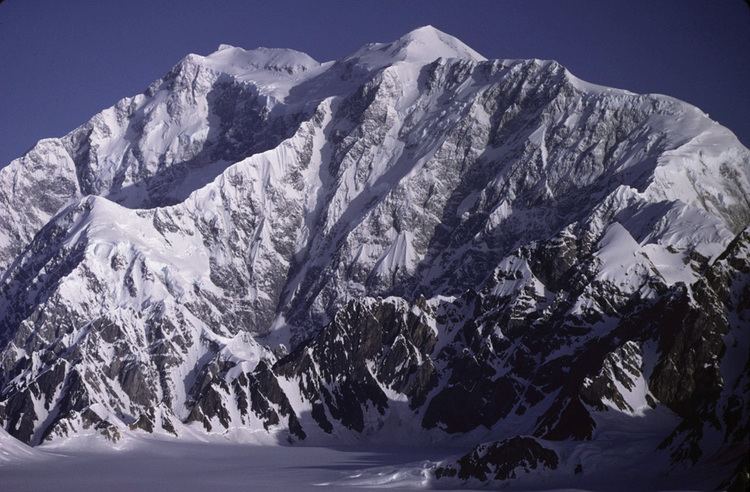Topo map NTS 115B Elevation 5,959 m Prominence 5,250 m | Easiest route glacier/snow/ice climb First ascent 23 June 1925 | |
 | ||
Isolation 624 kilometres (388 mi) Listing World most prominent peaks 6thSeven Second Summits 3rdCountry high points 15thNorth America highest peaks 2ndNorth America prominent peaks 2ndNorth America isolated peaks 22ndCanada highest major peaks 1st First ascenders A. Taylor, H. S. Hall, Jr., A. Carpe, H. F. Lambart Similar Mount Saint Elias, Denali, Mount Fairweather, Mount Steele, Pico de Orizaba | ||
Mount Logan /ˈloʊɡən/ is the highest mountain in Canada and the second-highest peak in North America, after Denali. The mountain was named after Sir William Edmond Logan, a Canadian geologist and founder of the Geological Survey of Canada (GSC). Mount Logan is located within Kluane National Park and Reserve in southwestern Yukon, less than 40 kilometres (25 mi) north of the Yukon/Alaska border. Mount Logan is the source of the Hubbard and Logan Glaciers. Logan is believed to have the largest base circumference of any non-volcanic mountain on Earth (a large number of shield volcanoes are much larger in size and mass), including a massif with eleven peaks over 5,000 metres (16,400 ft).
Contents
- Map of Mt Logan Yukon Unorganized Yukon Canada
- Peaks of the massif
- First ascent
- Subsequent notable ascents and attempts
- Proposed renaming
- May 2005 rescue
- References
Map of Mt Logan, Yukon, Unorganized, Yukon, Canada
Due to active tectonic uplifting, Mount Logan is still rising in height. Before 1992, the exact elevation of Mount Logan was unknown and measurements ranged from 5,959 to 6,050 metres (19,551 to 19,849 ft). In May 1992, a GSC expedition climbed Mount Logan and fixed the current height of 5,959 metres (19,551 ft) using GPS.
Temperatures are extremely low on and near Mount Logan. On the 5,000 m high plateau, air temperature hovers around −45 °C (−49 °F) in the winter and reaches near freezing in summer with the median temperature for the year around −27 °C (−17 °F). Minimal snow melt leads to a significant ice cap, reaching almost 300 m (984 ft) in certain spots.
Peaks of the massif
The Mount Logan massif is considered to contain all the surrounding peaks with less than 500 m (1,640 ft) of prominence, as listed below:
First ascent
In 1922, a geologist approached the Alpine Club of Canada with the suggestion that the club send a team to the mountain to reach the summit for the first time. An international team of Canadian, British and American climbers was assembled and initially they had planned their attempt in 1924 but funding and preparation delays postponed the trip until 1925. The international team of climbers began their journey in early May, crossing the mainland from the Pacific coast by train. They then walked the remaining 200 kilometres (120 mi) to within 10 kilometres (6 mi) of the Logan Glacier where they established base camp. In the early evening of June 23, 1925, Albert H. MacCarthy (leader), H.F. Lambart, Allen Carpé, W.W. Foster, Norman H. Read and Andy Taylor stood on top for the first time. It had taken them 65 days to approach the mountain from the nearest town, McCarthy, summit and return, with all climbers intact.
Subsequent notable ascents and attempts
Proposed renaming
Following the death of former Prime Minister Pierre Trudeau, Prime Minister Jean Chrétien, a close friend of Trudeau's, considered renaming the mountain Mount Trudeau; however, opposition from Yukoners, mountaineers, geologists, Trudeau's political critics, and many other Canadians forced the plan to be dropped. A mountain in British Columbia's Premier Range was named Mount Pierre Elliott Trudeau instead.
May 2005 rescue
During the last few days of May 2005, three climbers from the North Shore Search and Rescue team of North Vancouver became stranded on the mountain. A joint operation by Canadian and American forces rescued the three climbers and took them to Anchorage, Alaska for treatment of frostbite.
